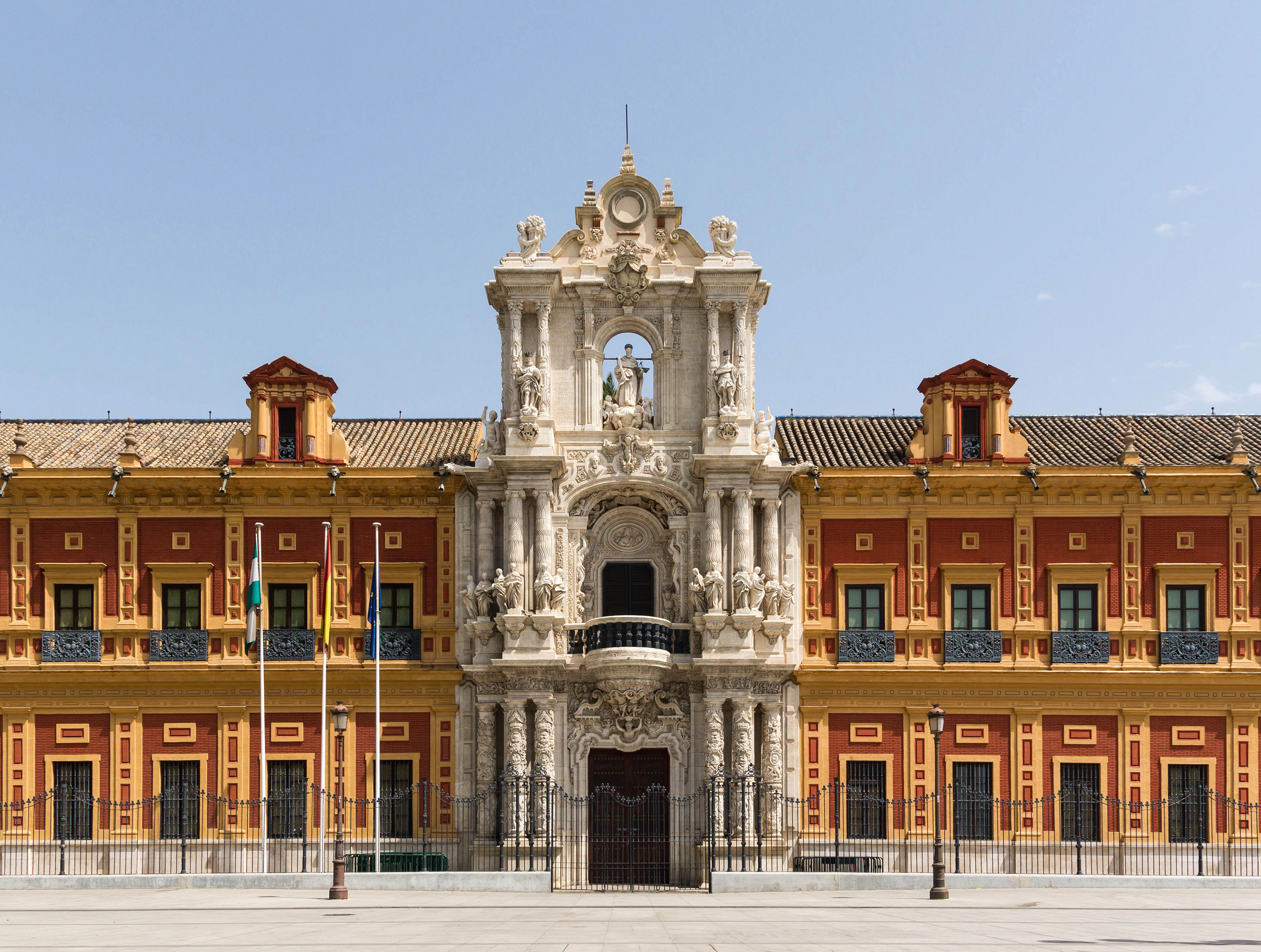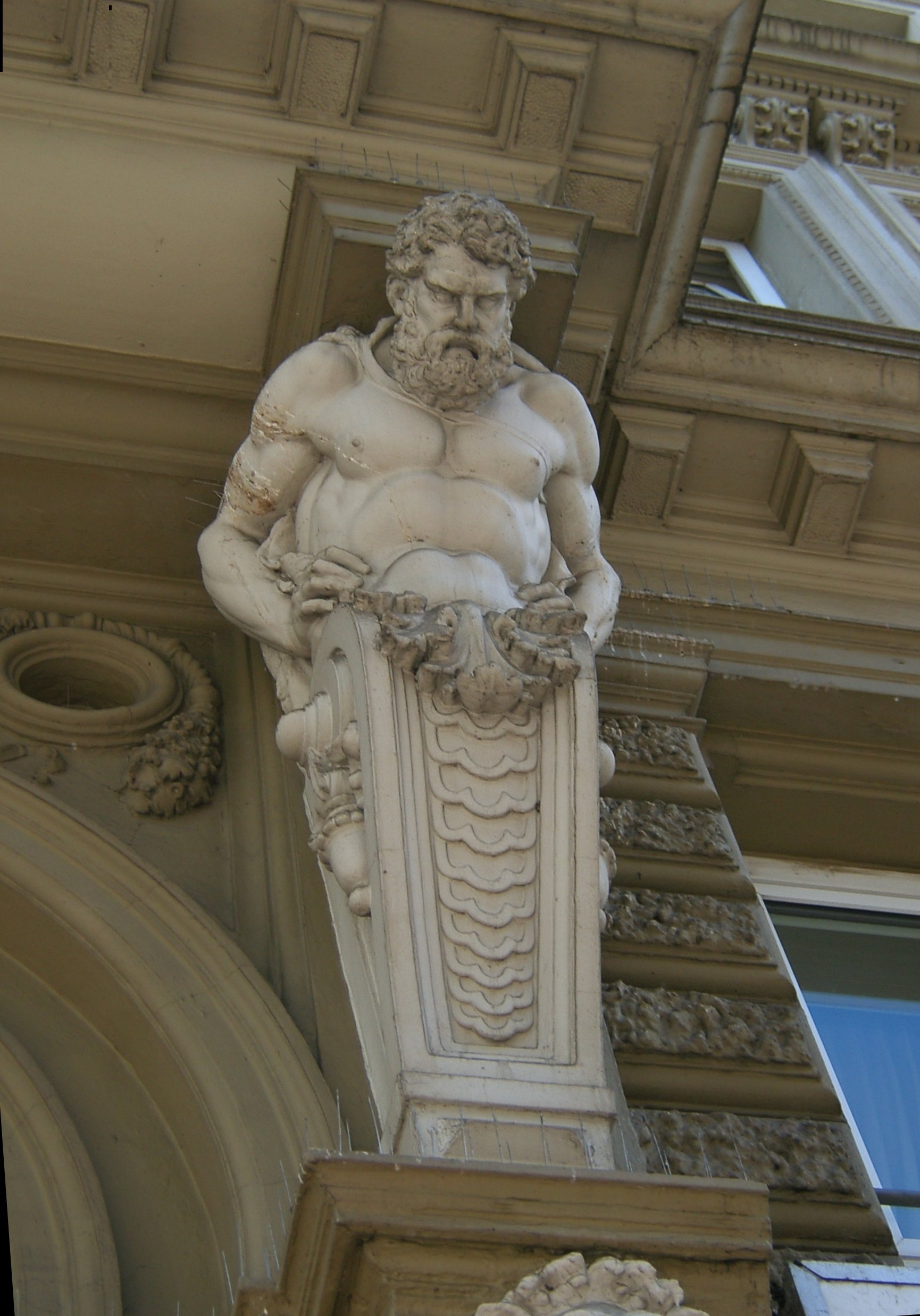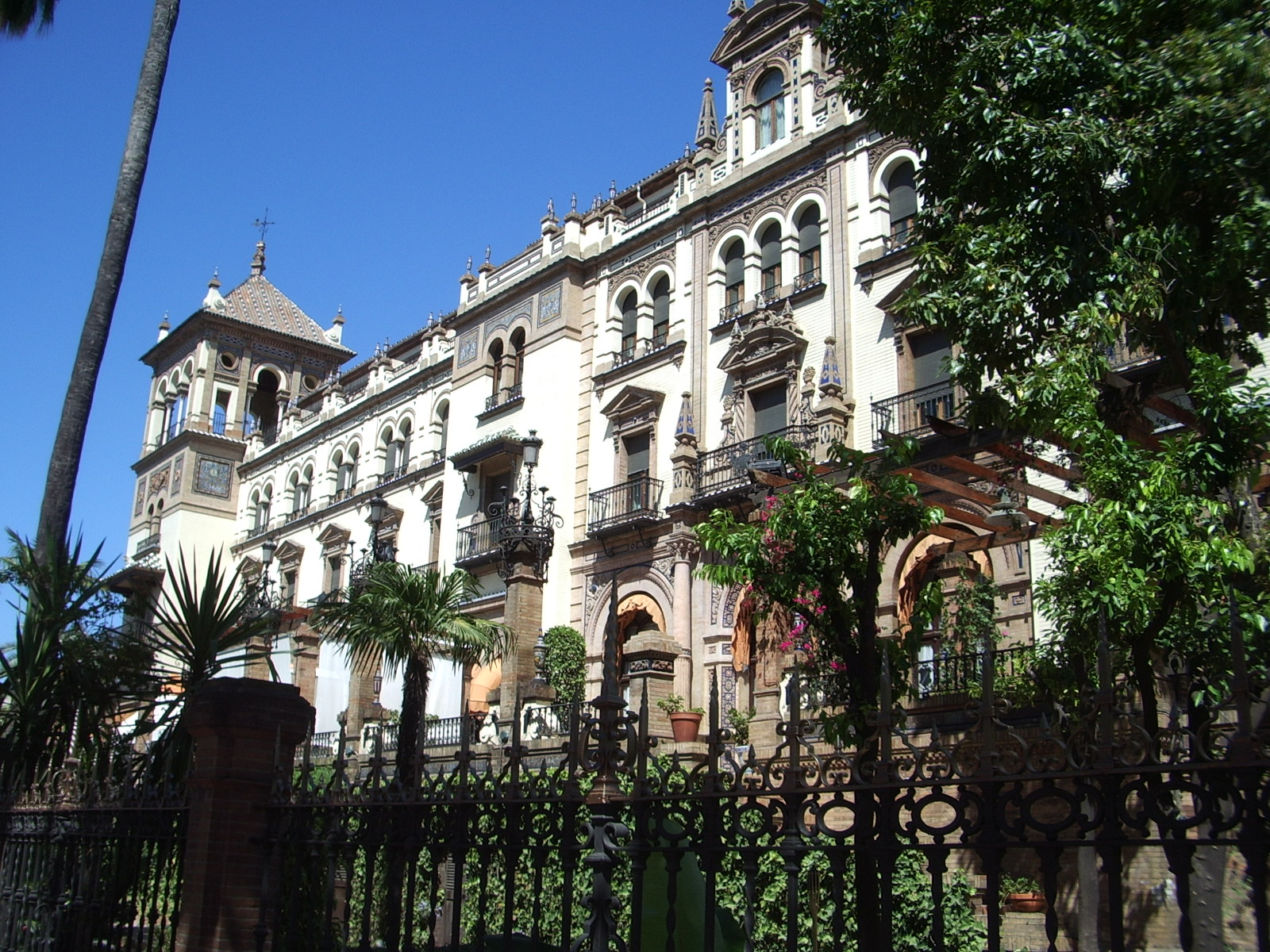|
Palace Of San Telmo
The Palace of San Telmo ( es, Palacio de San Telmo) is a historical edifice in Seville, southern Spain, formerly the ''Universidad de Mareantes'' (a university for navigators), now is the seat of the presidency of the Andalusian Autonomous Government. Construction of the building began in 1682 outside the walls of the city, on property belonging to the Tribunal of the Holy Office, the institution responsible for the Spanish Inquisition. It was originally constructed as the seat of the University of Navigators (''Universidad de Mareantes''), a school to educate orphaned children and train them as sailors. Description The palace is one of the emblematic buildings of Sevillian Baroque architecture. It is built on a rectangular plan, with several interior courtyards, including a central courtyard, towers on the four corners, a chapel, and gardens. The exuberantly baroque chapel, accessed from one of the courtyards, is the work of architect Leonardo de Figueroa; among those involved in ... [...More Info...] [...Related Items...] OR: [Wikipedia] [Google] [Baidu] |
Spanish Baroque Architecture
Spanish Baroque is a strand of Baroque architecture that evolved in Spain, its provinces, and former colonies. History As Italian Baroque influences penetrated across the Pyrenees, they gradually superseded in popularity the restrained classicizing approach of Juan de Herrera, which had been in vogue since the late sixteenth century. As early as 1667, the facades of Granada Cathedral (by Alonso Cano) and Jaén Cathedral (by Eufrasio López de Rojas) suggest the artists' fluency in interpreting traditional motifs of Spanish cathedral architecture in the Baroque aesthetic idiom. In Madrid, a vernacular Baroque with its roots in Herrerian and in traditional brick construction was developed in the Plaza Mayor and in the Royal Palace of ''El Buen Retiro'', which was destroyed during the French invasion by Napoleon's troops. Its gardens still remain as Parque del Buen Retiro. This sober brick Baroque of the 17th century is still well represented in the streets of the capital in pala ... [...More Info...] [...Related Items...] OR: [Wikipedia] [Google] [Baidu] |
Atlas (architecture)
In European architectural sculpture, an atlas (also known as an atlant, or atlante or atlantid; plural atlantes)''Aru-Az , Michael Delahunt ArtLex Art Dictionary , 1996–2008. is a support sculpted in the form of a man, which may take the place of a , a or a . The Roman term for such a sculptural support is |
Diego Rodríguez De Silva Y Velázquez
Diego is a Spanish masculine given name. The Portuguese equivalent is Diogo. The name also has several patronymic derivations, listed below. The etymology of Diego is disputed, with two major origin hypotheses: ''Tiago'' and ''Didacus''. Etymology ''Tiago'' hypothesis Diego has long been interpreted as variant of ''Tiago'' (Brazilian Portuguese: ''Thiago''), an abbreviation of ''Santiago'', from the older ''Sant Yago'' "Saint Jacob", in English known as Saint James or as ''San-Tiago''. This has been the standard interpretation of the name since at least the 19th century, as it was reported by Robert Southey in 1808 and by Apolinar Rato y Hevia (1891). The suggestion that this identification may be a folk etymology, i.e. that ''Diego'' (and ''Didacus''; see below) may be of another origin and only later identified with ''Jacobo'', is made by Buchholtz (1894), though this possibility is judged as improbable by the author himself. ''Didacus'' hypothesis In the later 20th ... [...More Info...] [...Related Items...] OR: [Wikipedia] [Google] [Baidu] |
Granada
Granada (,, DIN 31635, DIN: ; grc, Ἐλιβύργη, Elibýrgē; la, Illiberis or . ) is the capital city of the province of Granada, in the autonomous communities of Spain, autonomous community of Andalusia, Spain. Granada is located at the foot of the Sierra Nevada (Spain), Sierra Nevada mountains, at the confluence of four rivers, the Darro (river), Darro, the Genil, the Monachil (river), Monachil and the Beiro. Ascribed to the Vega de Granada ''comarca'', the city sits at an average elevation of Above mean sea level, above sea level, yet is only one hour by car from the Mediterranean coast, the Costa Tropical. Nearby is the Sierra Nevada Ski Station, where the FIS Alpine World Ski Championships 1996 were held. In the 2021 national census, the population of the city of Granada proper was 227,383, and the population of the entire municipal area was estimated to be 231,775, ranking as the Ranked lists of Spanish municipalities, 20th-largest urban area of Spain. About 3.3% of t ... [...More Info...] [...Related Items...] OR: [Wikipedia] [Google] [Baidu] |
Reconquista
The ' (Spanish, Portuguese and Galician for "reconquest") is a historiographical construction describing the 781-year period in the history of the Iberian Peninsula between the Umayyad conquest of Hispania in 711 and the fall of the Nasrid kingdom of Granada in 1492, in which the Christian kingdoms expanded through war and conquered al-Andalus; the territories of Iberia ruled by Muslims. The beginning of the ''Reconquista'' is traditionally marked with the Battle of Covadonga (718 or 722), the first known victory by Christian military forces in Hispania since the 711 military invasion which was undertaken by combined Arab- Berber forces. The rebels who were led by Pelagius defeated a Muslim army in the mountains of northern Hispania and established the independent Christian Kingdom of Asturias. In the late 10th century, the Umayyad vizier Almanzor waged military campaigns for 30 years to subjugate the northern Christian kingdoms. His armies ravaged the north, even s ... [...More Info...] [...Related Items...] OR: [Wikipedia] [Google] [Baidu] |
Rodrigo Ponce De León, Duke Of Cádiz
Rodrigo Ponce de Leon, Duke of Cádiz (1443–1492) was one of the Castilian military leaders in the conquest of Granada. In 1482 he led the Castilian forces that captured the town of Alhama and later Boabdil. He had earlier been one of the military leaders in the Castilian War of Succession. Juan Pacheco was his father-in-law. He was made 1st Duke of Cádiz in 1484 and succeeded briefly by his heir Francisca Ponce de León y de la Fuente. Ponce de León is also related to: * Juan Ponce de León * Juan Ponce de León II * Juan Ponce de León y Loayza Juan Ponce de León y Loayza (born San Juan, Puerto Rico) was the son of Juan Ponce de León II (born ''Juan Troche-Ponce de León''), the interim Spanish governor of Puerto Rico in 1579. His mother was Isabel de Loayza born in Villa Talavera ... Sources *Harold Livermore. ''A History of Spain''. New York: Grove Press, 1958. p. 192. {{DEFAULTSORT:Ponce de Leon, Rodrigo, Cadiz, Duke of, 01 1443 births 149 ... [...More Info...] [...Related Items...] OR: [Wikipedia] [Google] [Baidu] |
Juan Martínez Montañés
Juan Martínez Montañés (March 16, 1568 – June 18, 1649), known as el Dios de la Madera (''the God of Wood''), was a Spanish sculptor, born at Alcalá la Real, in the province of Jaén. He was one of the most important figures of the Sevillian school of sculpture. Biography Juan Martínez Montañés was born on March 16, 1568 in Alcalá la Real, Jaén, Spain. His master was Pablo de Roxas. His first known work, dating to 1597, is the graceful St. Christopher in the church of El Salvador at Seville. His ''Boy Christ'' (dated 1607) is in the sacristy of the cathedral of Seville. His masterpiece, the great altar of St Jerome at San Isidoro del Campo, Santiponce, near Seville, was contracted in 1609 and completed in 1613. Montañés executed most of his sculpture in wood, which was gessoed, polychromed and gilded. Other works were the great altars at Santa Clara in Seville and at San Miguel in Jerez, the Immaculate Conception and the realistic figure of Christ Crucified in ... [...More Info...] [...Related Items...] OR: [Wikipedia] [Google] [Baidu] |
Antonio Susillo
Antonio is a masculine given name of Etruscan origin deriving from the root name Antonius. It is a common name among Romance language-speaking populations as well as the Balkans and Lusophone Africa. It has been among the top 400 most popular male baby names in the United States since the late 19th century and has been among the top 200 since the mid 20th century. In the English language it is translated as Anthony, and has some female derivatives: Antonia, Antónia, Antonieta, Antonietta, and Antonella'. It also has some male derivatives, such as Anthonio, Antón, Antò, Antonis, Antoñito, Antonino, Antonello, Tonio, Tono, Toño, Toñín, Tonino, Nantonio, Ninni, Totò, Tó, Tonini, Tony, Toni, Toninho, Toñito, and Tõnis. The Portuguese equivalent is António (Portuguese orthography) or Antônio (Brazilian Portuguese). In old Portuguese the form Antão was also used, not just to differentiate between older and younger but also between more and less important. In Galician the ... [...More Info...] [...Related Items...] OR: [Wikipedia] [Google] [Baidu] |
Hotel Alfonso XIII
Hotel Alfonso XIII is a historic hotel in Seville, Spain, located on Calle San Fernando, next to the University of Seville. Designed by the architect José Espiau y Muñoz, it was built between 1916 and 1928 especially for the Ibero-American Exposition of 1929. It officially opened on April 28, 1929, with a sumptuous banquet attended by King Alfonso XIII and Queen Victoria Eugenie of Battenberg. The hotel is owned by the City of Seville and managed by The Luxury Collection division of Marriott International. History Designed by architect José Espiau y Muñoz, the hotel was built between 1916 and 1928, and officially inaugurated on 28 April 1929, with a celebration preceded by King Alfonso XIII and Queen Victoria Eugenia. The reason of the celebration was the wedding of Infanta Isabel with count Juan Zamoyski. The hotel was a winning project chosen among others after a contest was held under the direction of renowned architect Aníbal González. Espiau reached the award, a ... [...More Info...] [...Related Items...] OR: [Wikipedia] [Google] [Baidu] |
Palacio De San Telmo, Sevilla, España, 2015-12-06, DD 78
Palacio (''palace'') is a Spanish habitational name. It may have originated from many places in Spain, especially in Galicia and Asturies. Notable people with the surname include: *Agustina Palacio de Libarona (1825-1880), Argentine writer, storyteller, heroine *Alberto Palacio, engineer *Alfredo Palacio, former president of Ecuador *Andy Palacio, Belizean musician *Emilio Palacio, Ecuadorian journalist *Ernesto Palacio, opera singer *Héctor Palacio, Colombian road racing cyclist *Milt Palacio, basketball player *Rodrigo Palacio, footballer *R. J. Palacio, American writer of the 2012 children's novel ''Wonder'' See also * Palacios (other) Palacios may refer to: * Palacios (surname) * Palacios, Texas * Los Palacios, Cuba See also * Palacio Palacio (''palace'') is a Spanish habitational name. It may have originated from many places in Spain, especially in Galicia and Asturies. No ... References {{surname, Palacio Surnames of Spanish origin ... [...More Info...] [...Related Items...] OR: [Wikipedia] [Google] [Baidu] |
Hermenegild
Saint Hermenegild or Ermengild (died 13 April 585; es, San Hermenegildo; la, Hermenegildus, from Gothic ''*Airmana-gild'', "immense tribute"), was the son of king Liuvigild of the Visigothic Kingdom in the Iberian Peninsula and southern France. He fell out with his father in 579, then revolted the following year. During his rebellion, he converted from Arianism to Catholicism. Hermenegild was defeated in 584 and exiled. His death was later celebrated as a martyrdom due to the influence of Pope Gregory I's ''Dialogues'', in which he portrayed Hermenegild as a "Catholic martyr rebelling against the tyranny of an Arian father." Marriage to Ingund Hermenegild was the eldest son of Liuvigild and his first wife. He was a brother of Reccared I and brought up an Arian. Liuvigild made his sons co-regents. In 579, he married Ingund, the daughter of the Frankish King Sigebert I of Austrasia who was a Catholic. Her mother was the Visigoth princess Brunhilda of Austrasia. The twelve-y ... [...More Info...] [...Related Items...] OR: [Wikipedia] [Google] [Baidu] |
Ferdinand III Of Castile
Ferdinand III ( es, Fernando, link=no; 1199/120130 May 1252), called the Saint (''el Santo''), was King of Castile from 1217 and King of León from 1230 as well as King of Galicia from 1231. He was the son of Alfonso IX of León and Berenguela of Castile. Through his second marriage he was also Count of Aumale. Ferdinand III was one of the most successful kings of Castile, securing not only the permanent union of the crowns of Castile and León, but also masterminding the most expansive southward territorial expansion campaign yet in the Guadalquivir Valley, in which Islamic rule was in disarray in the wake of the decline of the Almohad presence in the Iberian Peninsula. By military and diplomatic efforts, Ferdinand greatly expanded the dominions of Castile by annexing the Guadalquivir river valley in the south of the Iberian Peninsula, establishing the boundaries of the Castilian state for the next two centuries. New territories included important cities such as Baeza, Úbeda, ... [...More Info...] [...Related Items...] OR: [Wikipedia] [Google] [Baidu] |


.jpg)


_-_attrib._Giovanni_Guercino_(MNAA438%2C_Paço_dos_Duques_de_Bragança).png)
